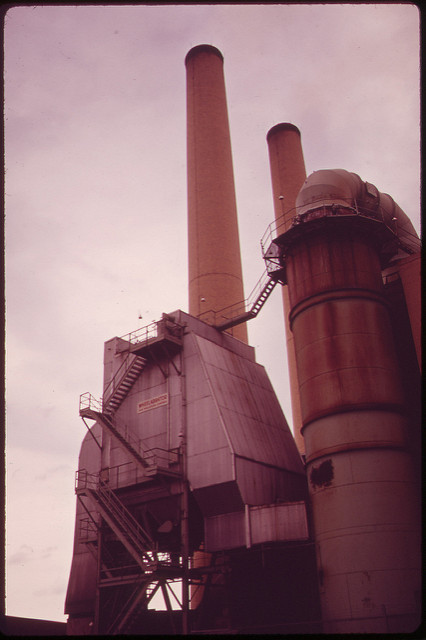Electrostatic Precipitators
Time to Read: 1m 55s
Electrostatic precipitators, or ESPs, are electronic filtration devices designed to remove fine particulates from a gas flow via an induced electrostatic charge (hence the name). These devices can remove dust, smoke, and other microscopic pollutants, and are generally used to treat gas flows used in industrial processing, or exhaust gases produced by such processing.  The first ESP installed in the U.S., Gravesend Bay Municipal Incineration Plant, Brooklyn, NY (May 1973)
The first ESP installed in the U.S., Gravesend Bay Municipal Incineration Plant, Brooklyn, NY (May 1973)
 The first ESP installed in the U.S., Gravesend Bay Municipal Incineration Plant, Brooklyn, NY (May 1973)
The first ESP installed in the U.S., Gravesend Bay Municipal Incineration Plant, Brooklyn, NY (May 1973)
Operation
Basic ESPs consist of a row or rows of thin, vertical, electrified wires in parallel alignment with a flat, metal, grounded plate or plates. Wire and plate spacing varies depending on the application. The gas flow travels forward (horizontally) through first the wires, then the plates. A high voltage negative charge is applied betwixt wires and plates, producing a corona discharge that ionizes the air and, subsequently, the particulate in the gas stream. Ionized particles are diverted via electrostatic force to the grounded collection plates. Particulate builds up on the plates and is removed from the gas flow.Performance
The collection efficiency of an electrostatic precipitator can be affected by the electrical resistivity of the particulate matter and by its particle size distribution. Electrical resistivity is the key concern. Particulate that is highly resistive is difficult to charge and, therefore, collect; and, once these high-resistivity particles are collected, they are difficult to discharge and remove from the ESP’s collection plate. Conversely, low-resistivity particulate is easy to charge and often discharges too easily, making collection difficult because the particles gather too quickly on the collector. Electrostatic precipitators can be calibrated to compensate for electrical resistivity levels. A series of relatively simple tests, either in the actual work environment in which the ESP is used or in a laboratory simulation of those conditions, can provide the data needed for proper calibration. Electrostatic precipitators are very energy efficient devices. Unlike wet scrubbers, which energize the fluid flow itself, ESPs’ electrostatic charges only energize the particulates that are being collected.Links
- Nol-Tec Systems specializes in industrial and utility air pollution mitigation, with over 30 years of experience. They are leading suppliers of high-performance electrostatic precipitators, providing ESPs that are customized and calibrated to each customer’s unique processing and environmental requirements.



